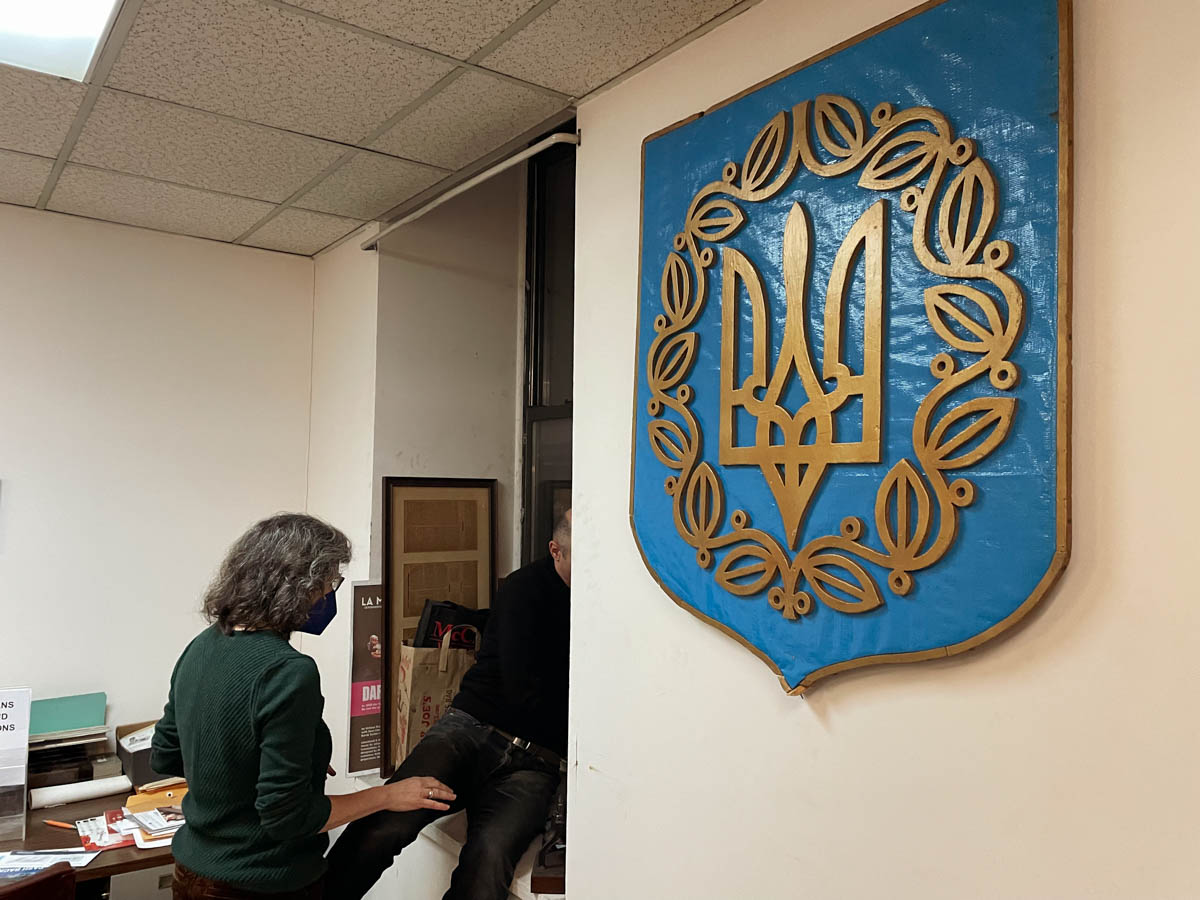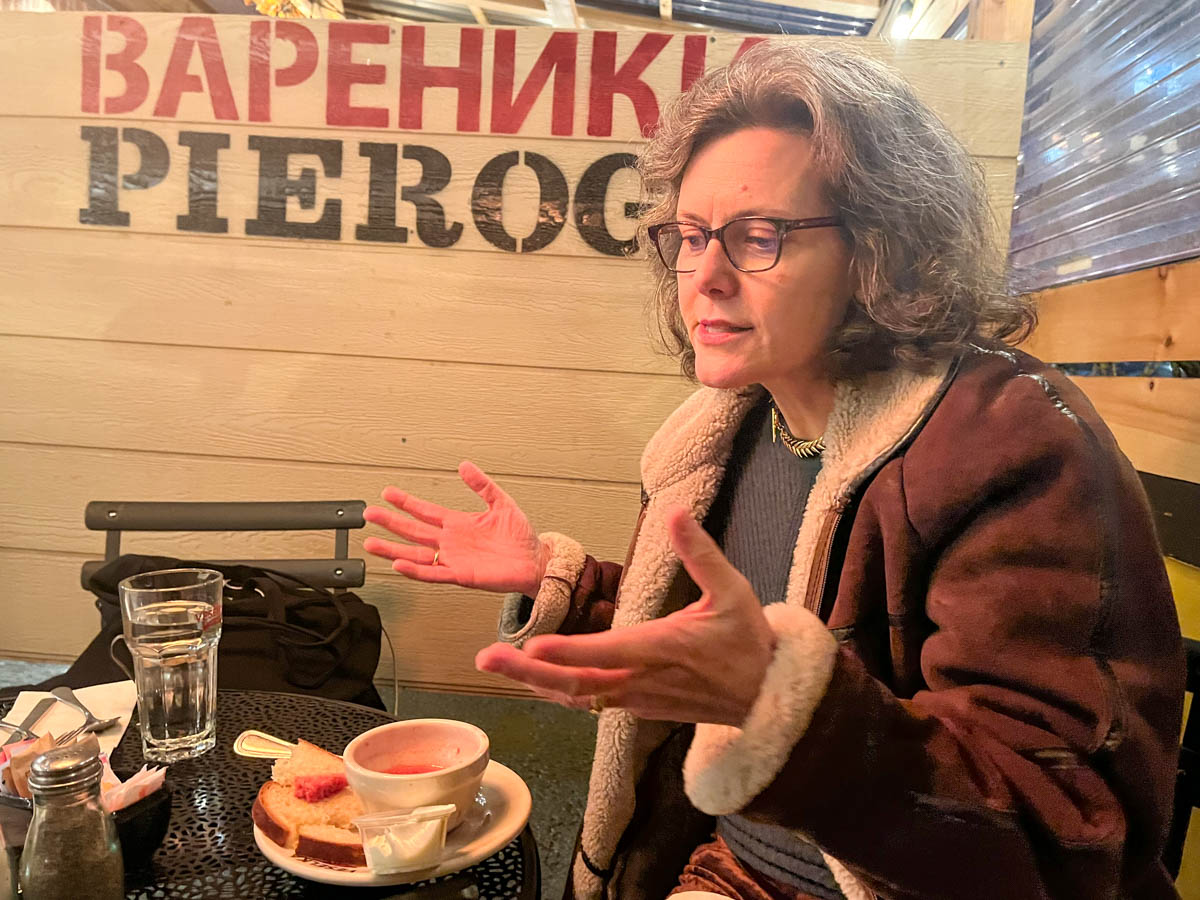
By Luke Cregan and Niamh Rowe
Under the fluorescent lighting of an office in Manhattan’s Lower East Side, a dozen or so Ukrainian New Yorkers met on the night on February 2. Over tea and chocolates, they grouped together in the Ukrainian National Home building to brainstorm a response to the latest threats of Russian invasion, 5,000 miles away. A row of megaphones sat near an empty donation box, and a well worn flip chart bore the name of the group: Razom. Dora Chomiak, the group’s president and a second-generation Ukrainian American, stood grinning as fellow activists sat down to work.
Her colleague Maryna Prykhodko led off the meeting with a quote: “Start by doing what’s necessary, then do what’s possible, and you’ll find you’re doing the impossible.” Prykhodko launched into the agenda: upcoming rallies, fundraising for humanitarian aid and pressuring US lawmakers through calls and emails.
With each item, the group was preparing to support Ukraine in the event of a huge escalation in an armed conflict with Russia that has already lasted eight years and taken more than 13,000 lives. Russian forces have spent recent weeks gathering on Ukraine’s borders and NATO leaders believe an incursion may be imminent. The meeting came just hours after President Joe Biden said he would send about 2,000 additional US troops to Europe to augment NATO’s presence.
Chomiak emphasized to reporters that the existential threat from Russia was not new. The only fresh development was the sudden international interest, as the United States’ and Russia’s maneuvers have captured headlines around the world. Her organization’s aim remains the same, Chomiak said: to promote the development of a prosperous Ukraine, one that is independent and democratic.
The organization emerged in 2014 from grassroots efforts by Ukrainian Americans to support pro-democracy protests back home in Kyiv’s Maidan square. “People just came out of the woodwork,” Chomiak said, “supporting their friends who were standing out in the freezing cold in the squares of Kyiv.” They rallied here and sent approximately $140,000 across the Atlantic that year for emergency needs like blankets and generators for protestors.
Those protests grew into the Maidan revolution, which overthrew Ukraine’s pro-Putin president in 2014. In response, Russia invaded and seized the Crimean Peninsula. At the same time, Russian soldiers posing as local paramilitaries moved into the Donbas region on Ukraine’s eastern border. Many people there consider themselves ethnically Russian and opposed Kyiv’s turn toward Europe. Russian-backed separatist militias have controlled swathes of the region since 2014. Their bloody stalemate with the Ukrainian military has claimed more than 13,000 lives and displaced more than 2 million people. If an invasion does take place, Ukraine’s Defense Ministry has cautioned that an additional five million people could be displaced.

Nearly a decade later, Chomiak said, “It’s exhausting. I’ve been paying for this for eight years.” Still, Chomiak is keen to take advantage of the spotlight. “Now, people are paying attention,” said Chomiak. “We have an opportunity to protest and rally.”
But the fact that the threat is now leveled against the entire Ukrainian state and its armed forces, not just protestors, has forced pro-Ukraine organizations in New York to evolve how they handled things in 2014. Razom joined longer-tenured groups like The Ukrainian Congress Committee of America and the Ukrainian National Women’s League of America. Both have their own decades-old traditions of sending humanitarian aid home and, like Razom, are now mulling how to respond to the latest crisis.
“Back then [in 2014], there were old ladies taking handfuls of change or telling people to help our guys with some proper socks,” said Andrij Dobriansky, director of communications for the Ukrainian Congress Committee of America. “But we are beyond that point. Now Ukraine has a real army. So now it’s like, how do we actually do anything?”
Professor Alexander Motyl, a political scientist at Rutgers University, said these challenges just mark the newest chapter in a long history of New Yorkers organizing on behalf of those back in Ukraine. “Starting in World War I and continuing to today, Ukrainians in general, and especially in the Lower East Side, have been staging demonstrations, mass meetings, or publishing pamphlets” to protest violations of national, civil, or human rights.
Motyl said the Manhattan neighborhood was once home to 20,000 to 30,000 Ukrainian immigrants, but only about 1,700 remain. Still, the neighborhood’s cultural and religious institutions, like the Ukrainian National Home, remain the nexus of communal organizing.
This February is Russia’s month as president of the UN Security Council. On the 17th, the next date when Ukraine will be discussed, Dobriansky and the UCCA are planning a demonstration outside of the UN headquarters. And on the anniversary of the conflict’s start, on February 20, Razom is planning to draw attention to Ukraine’s cause with a rally.
For now, New York’s Ukrainian community feels the weight of the waiting game that defines the lives of their relatives across the Atlantic. That feeling was on display when one activist spoke of her sense of “absolute helplessness” amid the grim headlines.
Her colleagues were quick to counter her. “You can really put yourself in a corner and start to feel really bad if you think, ‘Oh, this is going on and I can’t do anything about it,’” Prykhodko replied. “We need people to show up and do something.”
Editor’s note: Since this piece was first reported earlier this month, Russia’s armed forces moved into the contested Donbas region, further stoking fears of war.
About the author(s)
Niamh Rowe a multimedia reporter from London covering technology and social justice issues.



